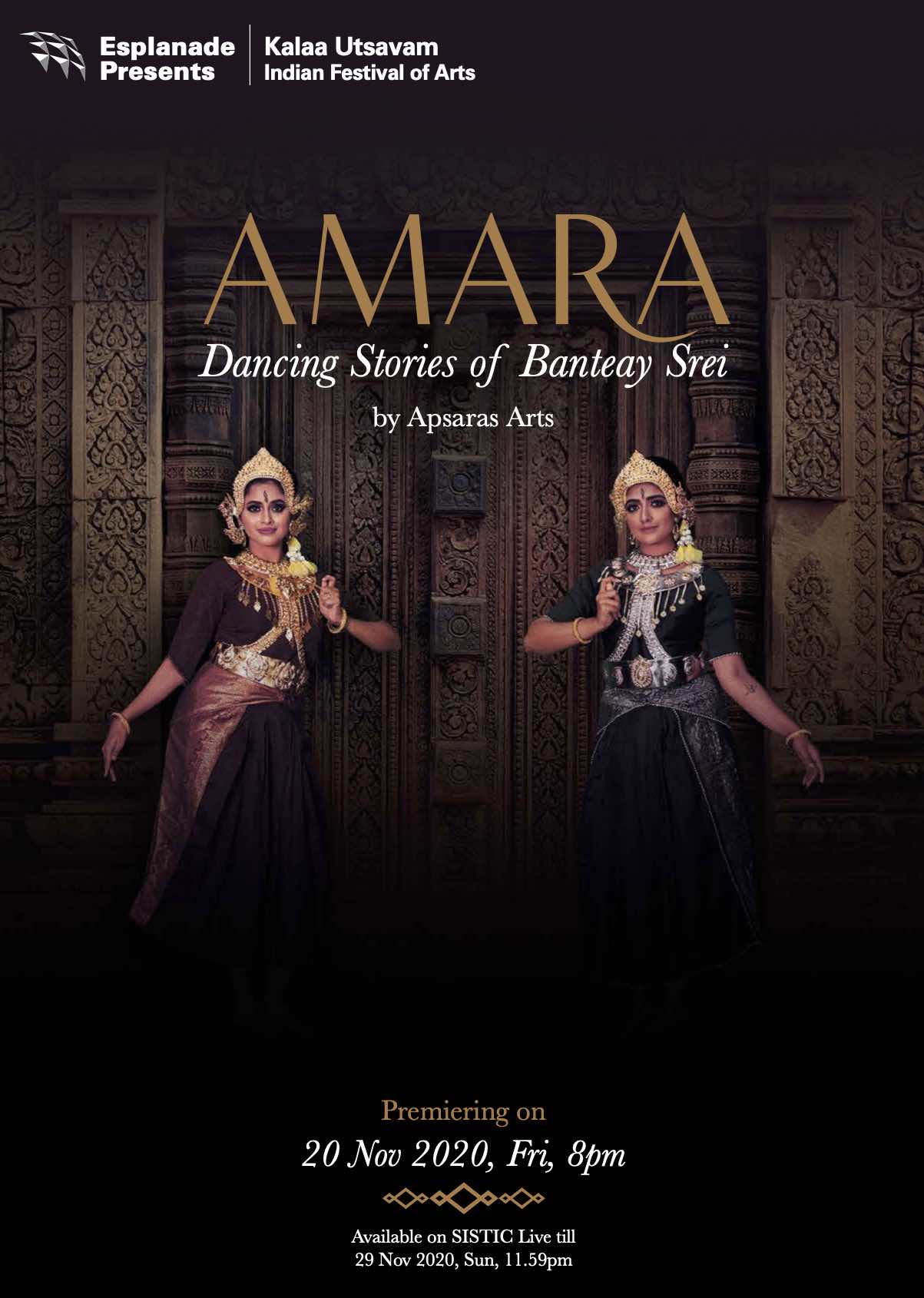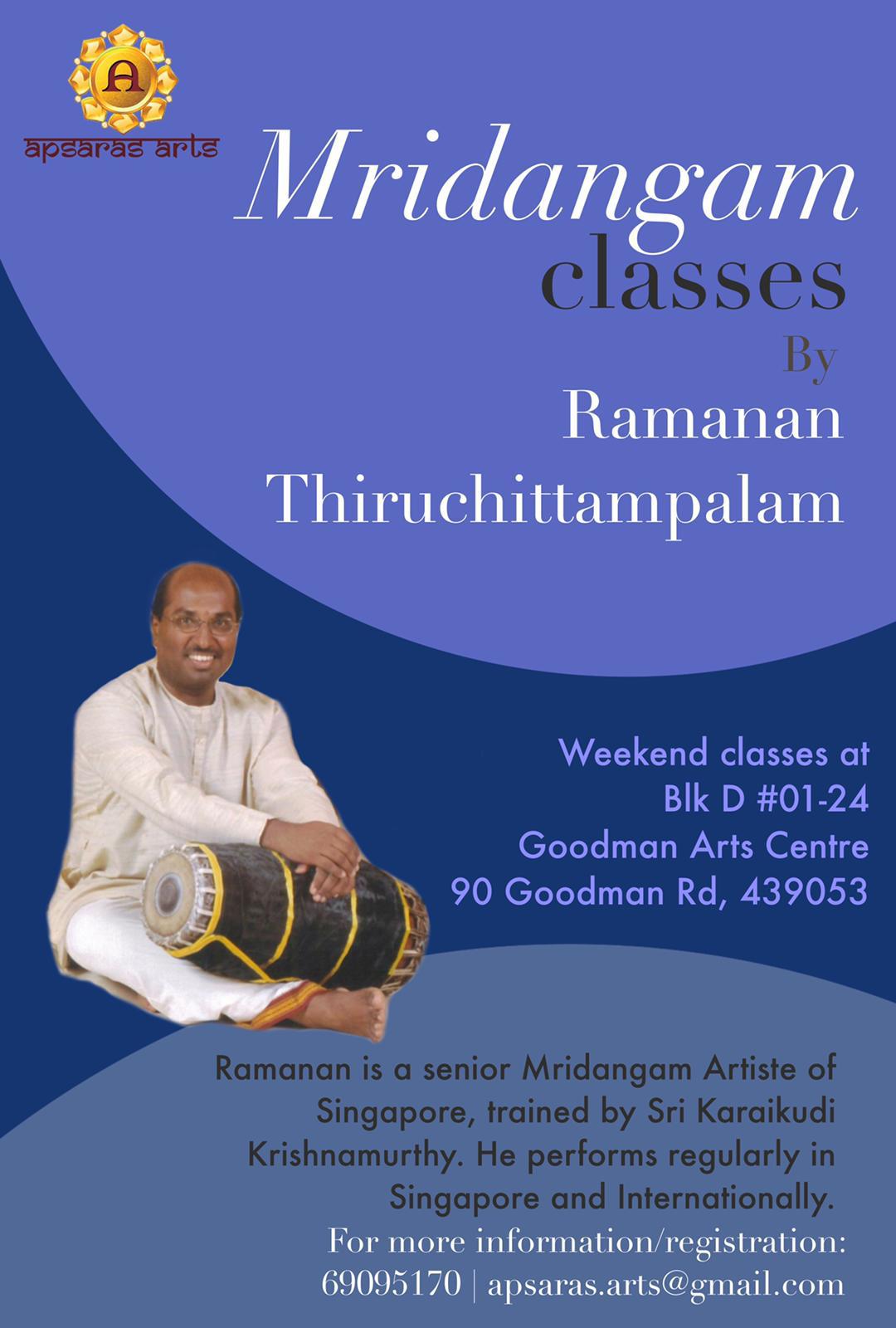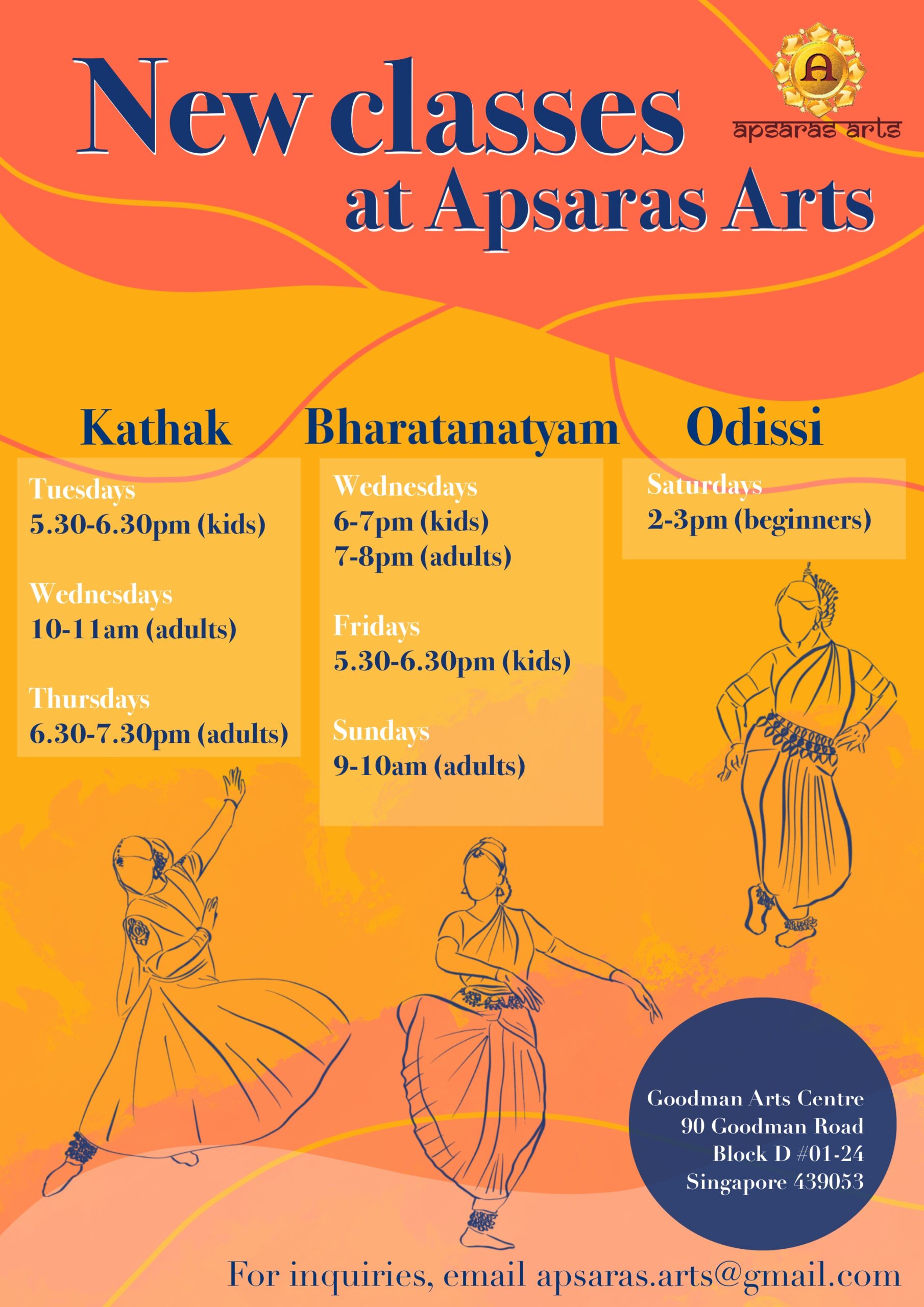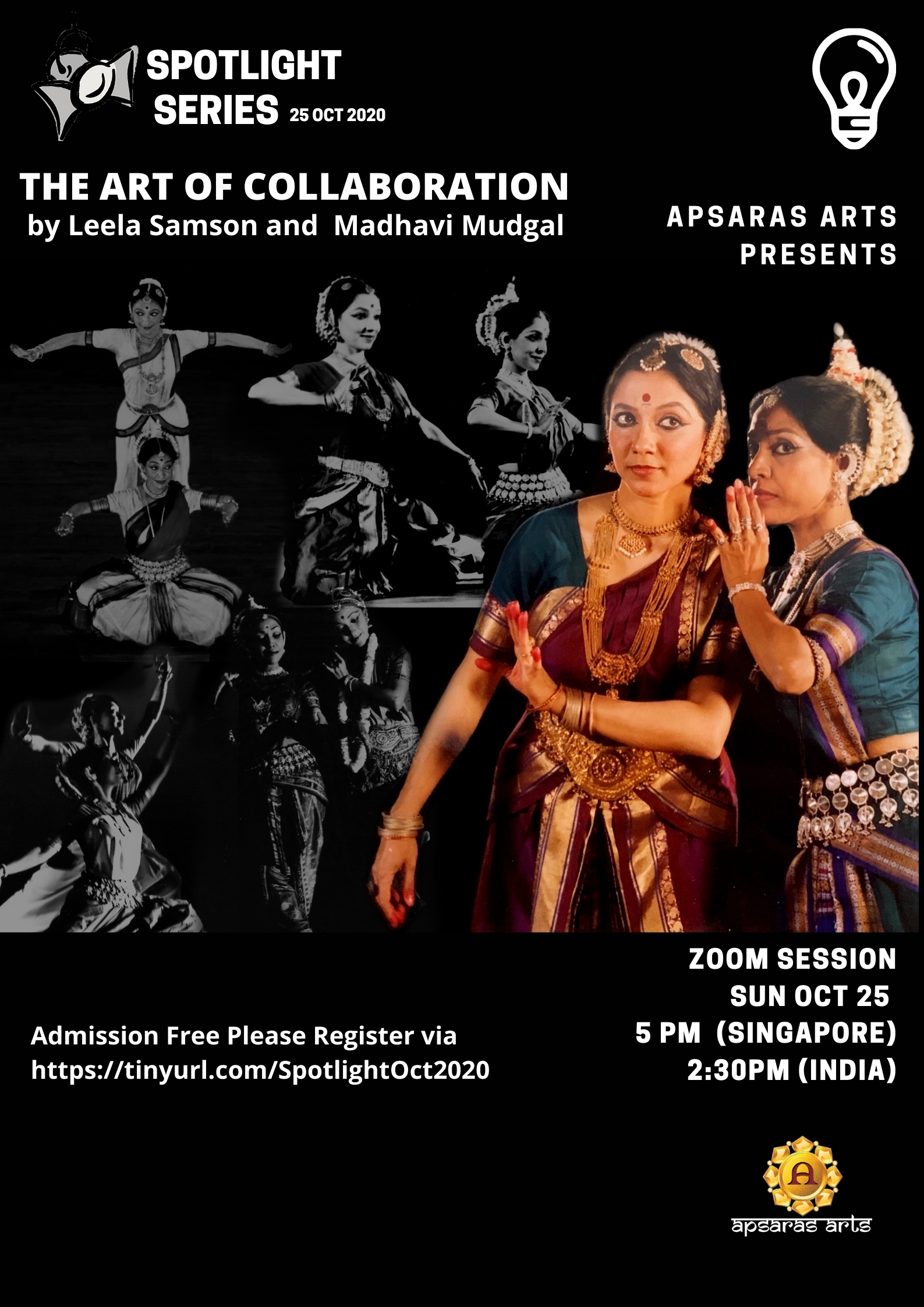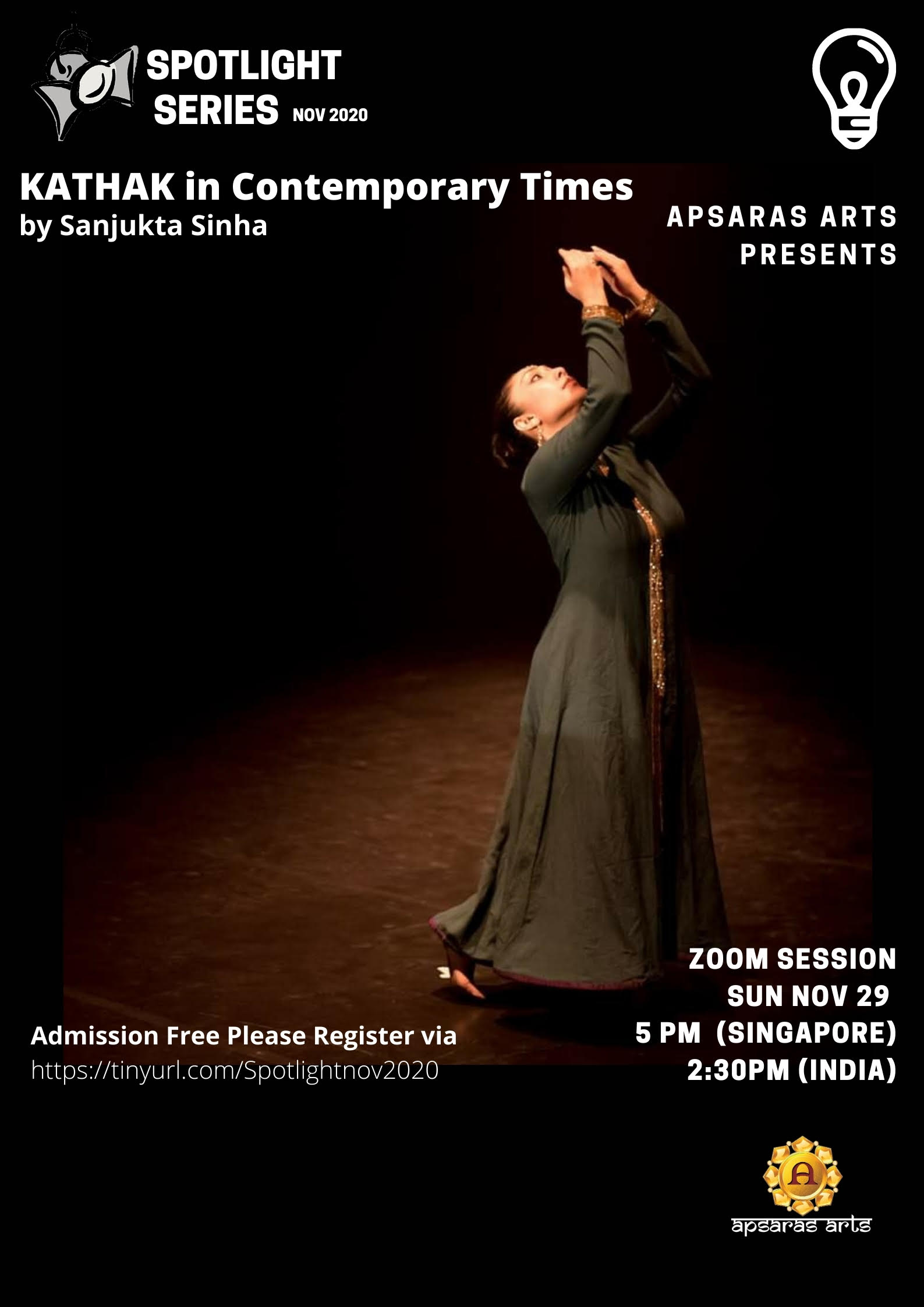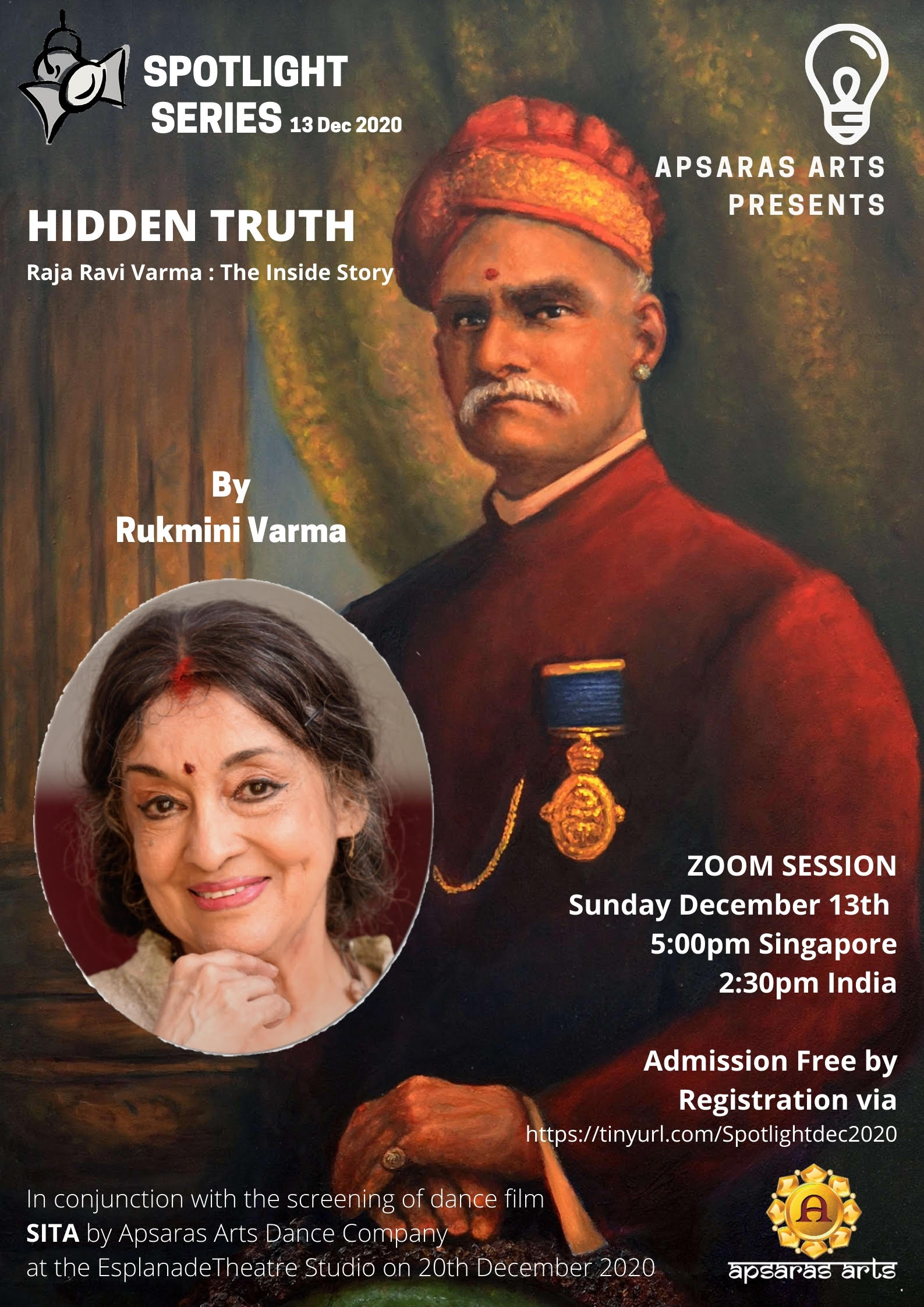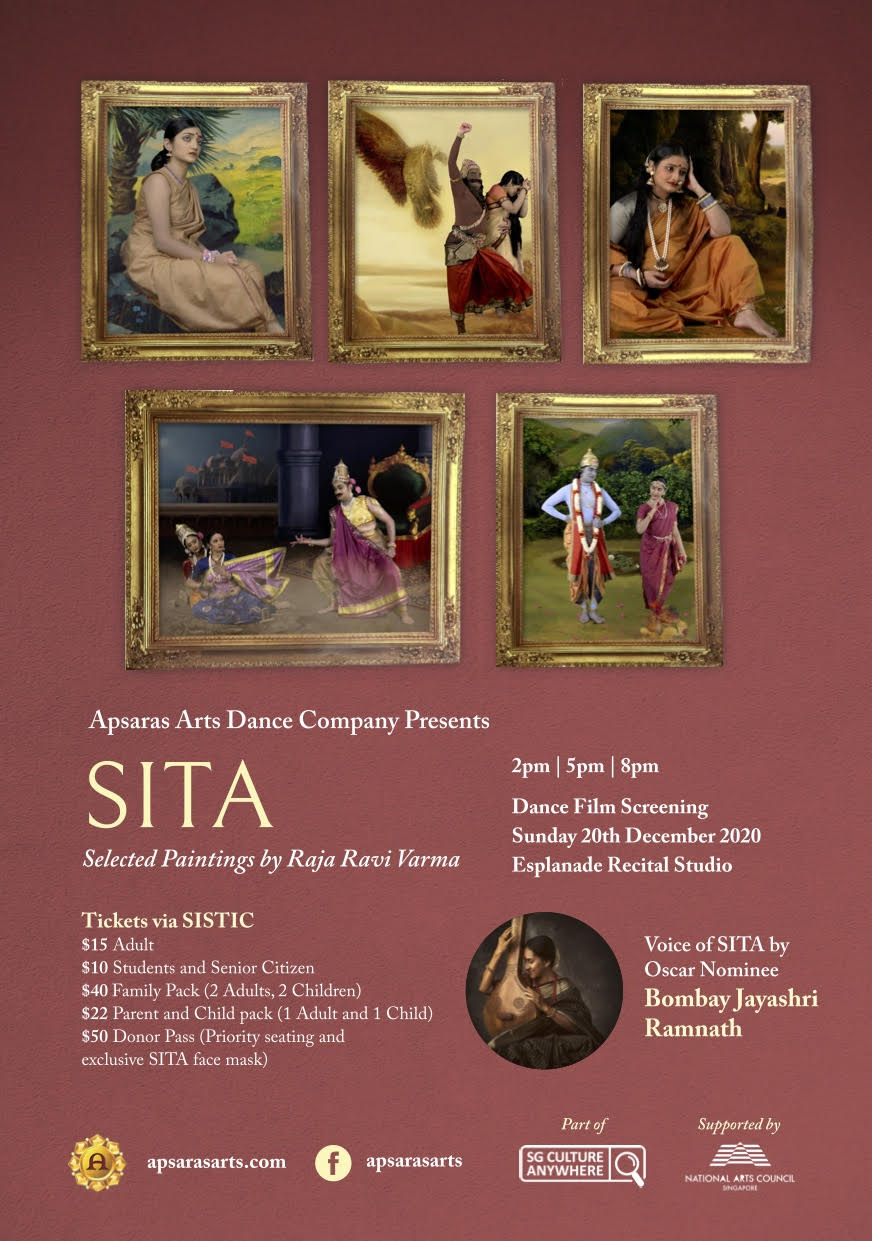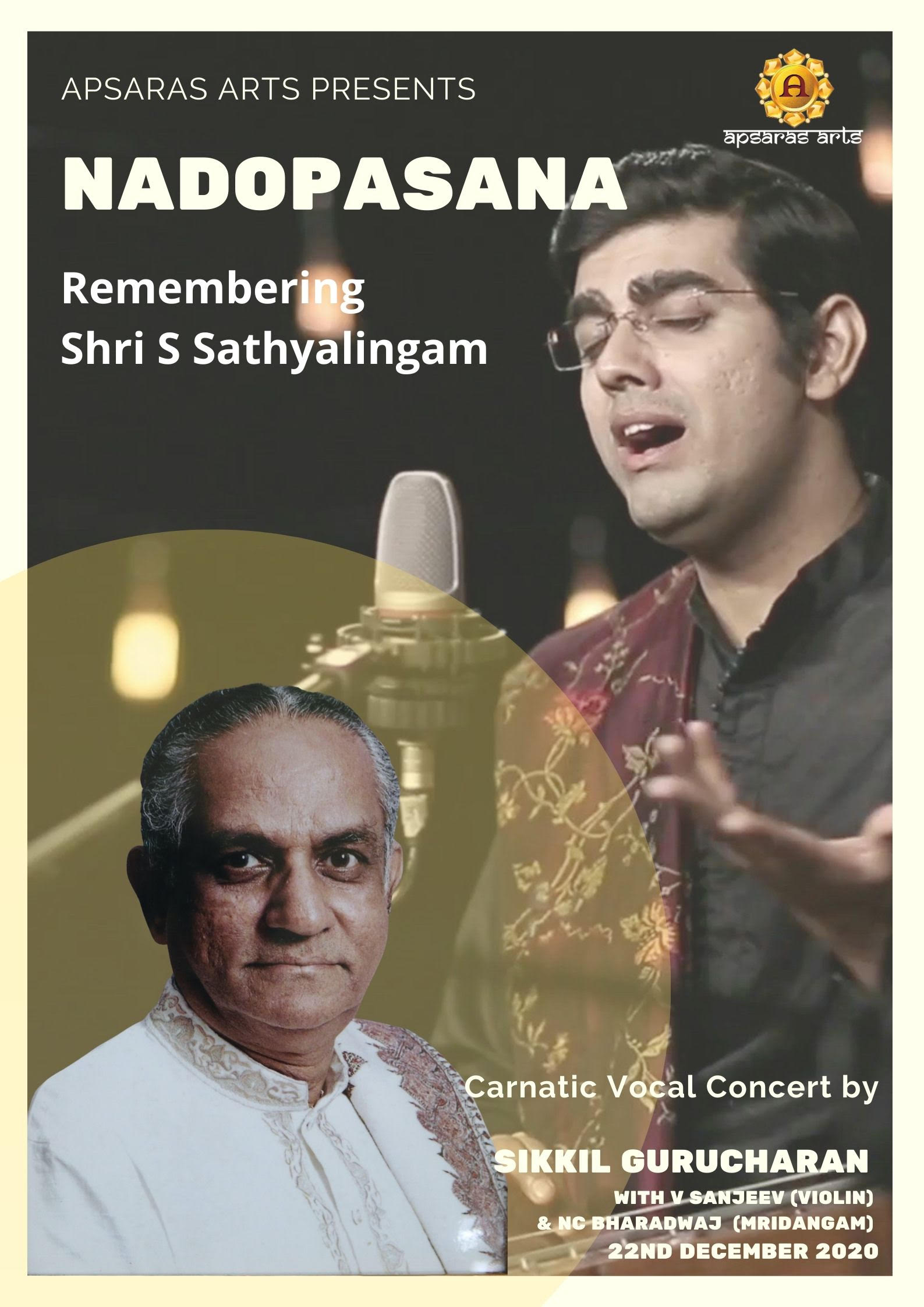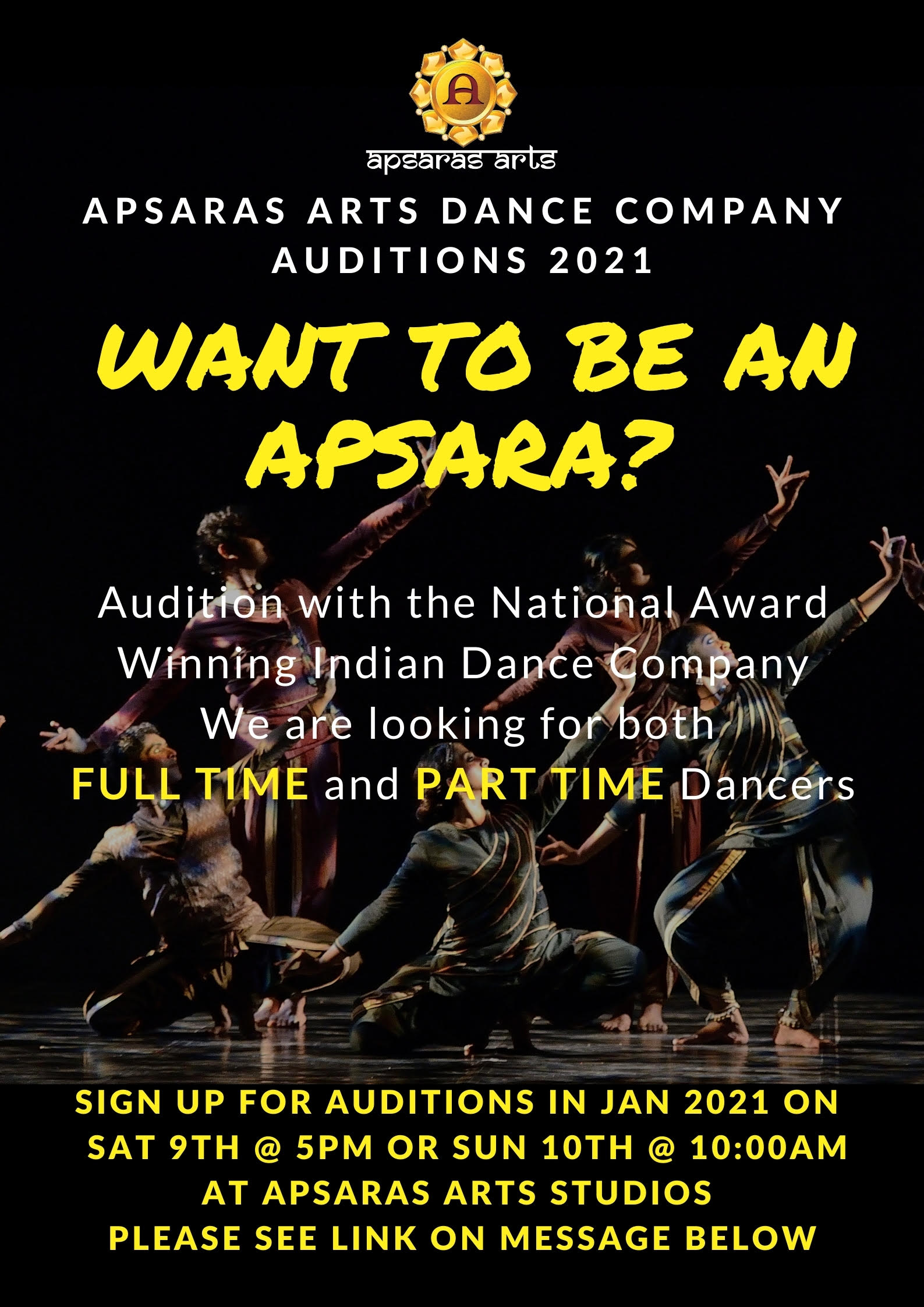AMARA – Making the Impossible Possible
Special Feature
by Mohanapriyan Thavarajah
 “From the forest of his matted locks, water flows and wets his neck, on which hangs the divine snake like a garland, and his drum incessantly plays damat, damat, damat, damat.” Thus, Shiva is engaged in a very vigorous Tandava dance, to bless and shower, prosperity on the entire universe. That day in the flowing water, I saw Shiva’s Lingas dance. My approach to the choreography is to portray the emotions that brim through these carvings at the Banteay Srei temple and bring them to live. In this production, the Yoginis will take us through the temple with dancing stories and the audience will be transported to the temple itself.
As we are looking forward to the premiere of Amara on 20th November, it served as an opportunity for me to share my experience of the creation of this production. During this unprecedented times of Covid-19, the making of Amara was not an easy task.
To keep our spirits up in this new normal, we took baby steps with Sita: the first digital production of Apsaras Arts. This work enlightened us with possibilities to think outside the box. Amara is an hour-long production which convinced us to adopt the 3D green chrome technology meaningfully.
My vivid memories of trips to Cambodia are still so fresh in my mind. Everything I saw there has deeply affected my thoughts and has served as an inspiration. The artistry of the Khmers is simply astonishing, I know their architecture is irreplaceable with any other creations of mankind but what awed me is their reimagination and interpretations of the concepts of religion and art. The idea of carving thousands of Lingas in the river bed of Mount Kulin is evidence of their brilliant imagination. They combined nature and religious symbols to create sacred surroundings not only in temples but wherever they could find space for divinity. I still remember touching the Linga in the middle of the flowing river and remembered the Shiva Thandav Strotra lines “From the forest of his matted lock, water flows and wets his neck, on which hangs the divine snake like a garland, and his drum incessantly plays damat, damat, damat, damat.” Thus, Shiva is engaged in a very vigorous Tandava dance, to bless and shower, prosperity on the entire universe.” That day in the flowing water, I saw Shiva’s Lingas dance.
Banteay Srei was the first temple that I visited in Cambodia. The soft pink stones of the temple aren’t immediately visually convincing as an architectural building but it resembled a dwelling made of ruby gem stone with cuts of intricate carvings. The details of carvings were similar to my father’s goldsmith works that I have often admired. The presiding deity is Chandrasekhara but interestingly, it is the Yoginis – beautiful female figurines which have been craved and celebrated all around the temple as a gesture of pride to their Matriarchal society of that time. The Hindu gods and goddess have been absorbed into the typical features of Khmer. It is noteworthy that the presiding deities of Angkor temples like Shiva and Vishnu appear majestic in their looks which are in sync with the concepts of king-god synergies.
The carvings of the Hindu gods and characters are often studied in the myths but in the Khmer style, these are not static carvings but they are in motion. Their body language and curves are so convincingly realistic and there is clarity in the expressions on their faces. My favourite sculptures are of Ravana lifting Mount Kailash and Mahishasuramardhini. Unlike the Indian version of Ravana with his horizontally aligned ten heads, the Khmers have visualised Ravana’s ten heads to be decked on top of each other like a mountain. This is where the visualisation is illuminating to a choreographer like myself in order to understand the emotions of characters in detail.
For example, by seeing Ravana’s heads decked the way, it shows his arrogance and the power he commands in his actions. The sculptors have also created motion with Ravana’s multiple hands lifting the mountain, easily more than 20 hands have been drawn capturing the enormous arm strength of his action. The level of detailed carving continues with Shiva seated calmly while all other divine beings including Parvati holding frightened expressions. In the case of Mahishasuramardhi, she is carved slaying the buffalo headed demon holding on his tail in an upside-down swift movement which shows us the power of goddess who ensures triumph over evil. In truth, stopping at any of these decorated lintels and looking up close at these carvings, one may realise these lively sculptures are breathing softly through the magical stones of Banteay Srei.
“From the forest of his matted locks, water flows and wets his neck, on which hangs the divine snake like a garland, and his drum incessantly plays damat, damat, damat, damat.” Thus, Shiva is engaged in a very vigorous Tandava dance, to bless and shower, prosperity on the entire universe. That day in the flowing water, I saw Shiva’s Lingas dance. My approach to the choreography is to portray the emotions that brim through these carvings at the Banteay Srei temple and bring them to live. In this production, the Yoginis will take us through the temple with dancing stories and the audience will be transported to the temple itself.
As we are looking forward to the premiere of Amara on 20th November, it served as an opportunity for me to share my experience of the creation of this production. During this unprecedented times of Covid-19, the making of Amara was not an easy task.
To keep our spirits up in this new normal, we took baby steps with Sita: the first digital production of Apsaras Arts. This work enlightened us with possibilities to think outside the box. Amara is an hour-long production which convinced us to adopt the 3D green chrome technology meaningfully.
My vivid memories of trips to Cambodia are still so fresh in my mind. Everything I saw there has deeply affected my thoughts and has served as an inspiration. The artistry of the Khmers is simply astonishing, I know their architecture is irreplaceable with any other creations of mankind but what awed me is their reimagination and interpretations of the concepts of religion and art. The idea of carving thousands of Lingas in the river bed of Mount Kulin is evidence of their brilliant imagination. They combined nature and religious symbols to create sacred surroundings not only in temples but wherever they could find space for divinity. I still remember touching the Linga in the middle of the flowing river and remembered the Shiva Thandav Strotra lines “From the forest of his matted lock, water flows and wets his neck, on which hangs the divine snake like a garland, and his drum incessantly plays damat, damat, damat, damat.” Thus, Shiva is engaged in a very vigorous Tandava dance, to bless and shower, prosperity on the entire universe.” That day in the flowing water, I saw Shiva’s Lingas dance.
Banteay Srei was the first temple that I visited in Cambodia. The soft pink stones of the temple aren’t immediately visually convincing as an architectural building but it resembled a dwelling made of ruby gem stone with cuts of intricate carvings. The details of carvings were similar to my father’s goldsmith works that I have often admired. The presiding deity is Chandrasekhara but interestingly, it is the Yoginis – beautiful female figurines which have been craved and celebrated all around the temple as a gesture of pride to their Matriarchal society of that time. The Hindu gods and goddess have been absorbed into the typical features of Khmer. It is noteworthy that the presiding deities of Angkor temples like Shiva and Vishnu appear majestic in their looks which are in sync with the concepts of king-god synergies.
The carvings of the Hindu gods and characters are often studied in the myths but in the Khmer style, these are not static carvings but they are in motion. Their body language and curves are so convincingly realistic and there is clarity in the expressions on their faces. My favourite sculptures are of Ravana lifting Mount Kailash and Mahishasuramardhini. Unlike the Indian version of Ravana with his horizontally aligned ten heads, the Khmers have visualised Ravana’s ten heads to be decked on top of each other like a mountain. This is where the visualisation is illuminating to a choreographer like myself in order to understand the emotions of characters in detail.
For example, by seeing Ravana’s heads decked the way, it shows his arrogance and the power he commands in his actions. The sculptors have also created motion with Ravana’s multiple hands lifting the mountain, easily more than 20 hands have been drawn capturing the enormous arm strength of his action. The level of detailed carving continues with Shiva seated calmly while all other divine beings including Parvati holding frightened expressions. In the case of Mahishasuramardhi, she is carved slaying the buffalo headed demon holding on his tail in an upside-down swift movement which shows us the power of goddess who ensures triumph over evil. In truth, stopping at any of these decorated lintels and looking up close at these carvings, one may realise these lively sculptures are breathing softly through the magical stones of Banteay Srei.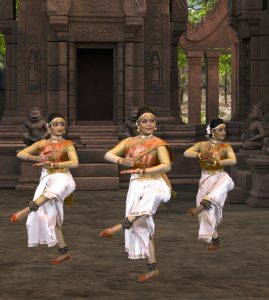 My approach to the choreography is to portray the emotions that brim through these carvings and bring them to live. In this production, the Yoginis will take us through the temple with dancing stories and the audience will be transported to the temple itself. You will need to watch the production to behold this for yourself.
With safety distance measures, the dancers had to deal with many restrictions in the day long shoots. This production is filmed using the green screen chrome technology where perspectives of dancers are changed for the cameras to capture the best of their moves. This was a new approach for us as we had to dynamically adapt ourselves to change, to add something on the spot to meet the expectations of the director, of the visuals planned. The challenge lay in sustaining the stamina and still evoke rasa in repetitive, multiple shots. This experience has been a great learning lesson in the need for patience, focus and determination.
Getting the costumes ready for Amara was a hunt in the tunnels. As we knew that we have very limited resources in Singapore and with no travel and courier exchanges between countries – complicated. This journey enabled me to explore Singapore’s textile sector and allowed me to find the closest fabrics similar to Cambodian Ikats and Silks. I had the pleasure of working with Vani and Palani, two exceptionally committed tailors who came forward to stitch the costumes for Amara with a fine touch. Despite the demands of Deepavali festivity buzzing around little India, it was challenging to negotiate a tailor’s time to make dance costumes, but these tailors gave me priority to sew the costumes with specific designs and details that I insisted on. This was a new experience and challenging for them and this process has enabled them to sew such costumes in Singapore in future for anyone. My heartfelt thanks to them.
My approach to the choreography is to portray the emotions that brim through these carvings and bring them to live. In this production, the Yoginis will take us through the temple with dancing stories and the audience will be transported to the temple itself. You will need to watch the production to behold this for yourself.
With safety distance measures, the dancers had to deal with many restrictions in the day long shoots. This production is filmed using the green screen chrome technology where perspectives of dancers are changed for the cameras to capture the best of their moves. This was a new approach for us as we had to dynamically adapt ourselves to change, to add something on the spot to meet the expectations of the director, of the visuals planned. The challenge lay in sustaining the stamina and still evoke rasa in repetitive, multiple shots. This experience has been a great learning lesson in the need for patience, focus and determination.
Getting the costumes ready for Amara was a hunt in the tunnels. As we knew that we have very limited resources in Singapore and with no travel and courier exchanges between countries – complicated. This journey enabled me to explore Singapore’s textile sector and allowed me to find the closest fabrics similar to Cambodian Ikats and Silks. I had the pleasure of working with Vani and Palani, two exceptionally committed tailors who came forward to stitch the costumes for Amara with a fine touch. Despite the demands of Deepavali festivity buzzing around little India, it was challenging to negotiate a tailor’s time to make dance costumes, but these tailors gave me priority to sew the costumes with specific designs and details that I insisted on. This was a new experience and challenging for them and this process has enabled them to sew such costumes in Singapore in future for anyone. My heartfelt thanks to them.
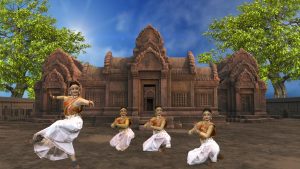 Three creative teams have worked simultaneously from two parts of the word but all our hearts, thoughts and ideas were always together to make the impossible possible. My heartfelt gratitude to those who have worked tirelessly for this project. Music composition by Rajkumar Bharathi, Vocals by Srikanth, Vijayaragavan, Keerthana and Savitha Narasimhan, Mridangam by Karthik, Violin by Easwar, Flute by Shruti Sagar and Vishnu Vijay, percussions by Ganapathi and Sai Shraavam, sound design by Sai Shravanam. Aravinth Kumarasamy has been a driving force as well as directing the entire production, Narration by Seema Hari Kumar and voice over by Priyadarshini Govind. Production house operations by Vijaya Nadeson and Vidhya Nair and styling, make up by Kesavan, Shankari, Selvi and Nagaletchumi. Tech production operations by Navin and team, choreography and costume designs by myself and I also danced in some of the stories of the carvings.
Amara is presented by Esplanade Theatres of the bay for Kala Utsavam – Indian Festival of Arts. Please buy your tickets and catch the premier through SISTIC from 20th November at 8pm (Singapore time). This screening is available for viewing till 29th November 1159pm (Singapore time) and can be seen around the world.
Three creative teams have worked simultaneously from two parts of the word but all our hearts, thoughts and ideas were always together to make the impossible possible. My heartfelt gratitude to those who have worked tirelessly for this project. Music composition by Rajkumar Bharathi, Vocals by Srikanth, Vijayaragavan, Keerthana and Savitha Narasimhan, Mridangam by Karthik, Violin by Easwar, Flute by Shruti Sagar and Vishnu Vijay, percussions by Ganapathi and Sai Shraavam, sound design by Sai Shravanam. Aravinth Kumarasamy has been a driving force as well as directing the entire production, Narration by Seema Hari Kumar and voice over by Priyadarshini Govind. Production house operations by Vijaya Nadeson and Vidhya Nair and styling, make up by Kesavan, Shankari, Selvi and Nagaletchumi. Tech production operations by Navin and team, choreography and costume designs by myself and I also danced in some of the stories of the carvings.
Amara is presented by Esplanade Theatres of the bay for Kala Utsavam – Indian Festival of Arts. Please buy your tickets and catch the premier through SISTIC from 20th November at 8pm (Singapore time). This screening is available for viewing till 29th November 1159pm (Singapore time) and can be seen around the world.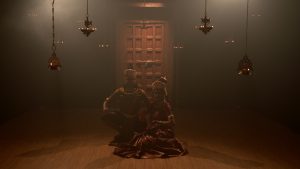 We mostly look up to Western history and artistes like Picasso, Michelangelo & others like them but in our region, we ignore & fail to recognise, study and celebrate our own treasures which have contributed so much to our Asian value system and roots. An Asian country like Cambodia has produced such sacred monuments like Banteay Srei. It’s sad that as we celebrate the staggering talents of Khmer artisans, they collectively remain faceless and nameless to us. Their artistry has stood the legacy of time and remains incomparable and forever accomplished and respected.
As a proud Asian, I cherish this moment for me as Apsaras Arts Dance Company dares to explore such treasures with intensive research and is able to present it through a showcase of dance and music.I’m sure this will be a great source of entertainment, education and enlightenment to the senses. The French explorers have rediscovered the Kingdom of Cambodia and allowed for it to be trumpeted to the world and it’s our time to hold us treasures proudly so that the next generations will be rooted with Asian sensibilities and sensitivities towards the arts and culture. Catch Amara and be proud of Incredible Asia and our brilliant Artisans.
We mostly look up to Western history and artistes like Picasso, Michelangelo & others like them but in our region, we ignore & fail to recognise, study and celebrate our own treasures which have contributed so much to our Asian value system and roots. An Asian country like Cambodia has produced such sacred monuments like Banteay Srei. It’s sad that as we celebrate the staggering talents of Khmer artisans, they collectively remain faceless and nameless to us. Their artistry has stood the legacy of time and remains incomparable and forever accomplished and respected.
As a proud Asian, I cherish this moment for me as Apsaras Arts Dance Company dares to explore such treasures with intensive research and is able to present it through a showcase of dance and music.I’m sure this will be a great source of entertainment, education and enlightenment to the senses. The French explorers have rediscovered the Kingdom of Cambodia and allowed for it to be trumpeted to the world and it’s our time to hold us treasures proudly so that the next generations will be rooted with Asian sensibilities and sensitivities towards the arts and culture. Catch Amara and be proud of Incredible Asia and our brilliant Artisans.
Cover story
COVER STORY Three costume designers Lakshmi Srinath, Sandhya Raman and Mohanapriyan Thavarajah from Chennai, Delhi and Singapore respectively, share their process, insights and views on designing and creating costume for dance and dancers Lakshmi Srinath “My interest in costume grew organically as a result of my passion and career as a visual artist” “My interest ... Read more
Aug 18, 2023
Read More >Cover story
COVER STORY Into the Music of Dance Our Cover story this edition features three musicians and music composers for dance from India, who share their experiences of making music for dance SUDHA RAGHURAMAN Carnatic Vocalist, Composer and Music Arranger What is that characteristic aspect that differentiates composing music for dance and composing music in general? ... Read more
Jun 1, 2023
Read More >Cover story
COVER STORY Master Weaver of Magic Raising a toast to Aravinth Kumarasamy, Artistic Director of Apsaras Arts, as he receives one of the most prestigious accolades for arts practitioners in Singapore – the Cultural Medallion… In the first week of December, Apsaras Arts Artistic Director Aravinth Kumarasamy, the man who needs no introduction to the ... Read more
Feb 16, 2023
Read More >Cover Story
Cover Story Dance of the Camera What happens when dance is on film? Do things shift for the artiste and choreographer when they are being seen through the camera’s eye? How do they negotiate this medium to create a work-of-art that is authentic to the dance and to cinema? Three senior Bharatanatyam artitses – Aravinth ... Read more
Oct 31, 2022
Read More >Cover story
COVER STORY Privilege, possibilities and experiences… We reached out to six Bharatanatyam male artistes from across the globe and asked them a common set of questions to feel enriched with a plethora of ideas and insights on inclusivity, gender-neutrality, exploration and experimentation, research and expression and about the beauty of art and how it enables ... Read more
Aug 29, 2022
Read More >Cover story
COVER STORY Let’s Talk Conservation Two young and talented Bharatanatyam artistes, Mahathi Kannan and Manasvini Ramachandran, share their interest, journey in working with the tangible and intangible in the arts… An interview Qus : What has been your fascination with the idea of heritage? When did you know that you wanted to study it formally ... Read more
Jun 24, 2022
Read More >Vision for Dance 2022
Vision for Dance 2022 A straight-from-the-heart response from dancers and curators on their vision for dance Rama Vaidyanathan Bharatanatyam exponent “My vision for dance this year is to bring it back to stage; in front of a live audience. I am also hoping that when dance returns full-fledged to stage, it is enriched and nuanced, ... Read more
Mar 8, 2022
Read More >National Award for Apsaras Arts Dance Company
Presented by National Heritage Board of Singapore on 10th December 2020 Acceptance speech by Aravinth Kumarasamy, Artistic Director of Apsaras Arts Dance Company. “Dear Guest of Honour, Minister of Culture, Community and Youth, Mr. Edwin Tong, Ms. Yeoh Chee Yan, Chairman of NHB, and Ms. Chang Hwee Nee, CEO of NHB. Good afternoon. Receiving this ... Read more
Dec 30, 2020
Read More >Dancing the Stories of Banteay Srei
AMARA: Dancing the Stories of Banteay Srei Inspired by the legends and the stories carved in its bas reliefs of the enchanting temple of Banteay Srei, this dance production brings to life the female divine Yoginis of the temple, which was once called the “citadel for women.” Apsaras Arts Dance Company is proud to present ... Read more
Oct 21, 2020
Read More >Odissi Dance Exchange: ODE by ETHOS
Over the months of May to July, Soumee De, Odissi faculty of Apsaras Arts, curated a series of webcast session for dance students, performers and teachers by inviting scholars, researchers and experts to share their practice, knowledge and experiences over an interactive dialogue. Over 10 episodes on Friday evenings, this series featured eminent speakers on ... Read more
Jul 20, 2020
Read More >Subscribe to our newsletter
to keep up to date with all our shows, performance tours, workshops & opportunities.
Individual Devata Sponsors
Address: Block D #01-24 90 Goodman Road Singapore 439053 | Email: apsaras.arts@gmail.com
© 2018 Apsaras Arts Indian Premier Dance Company. All Rights Reserved.







